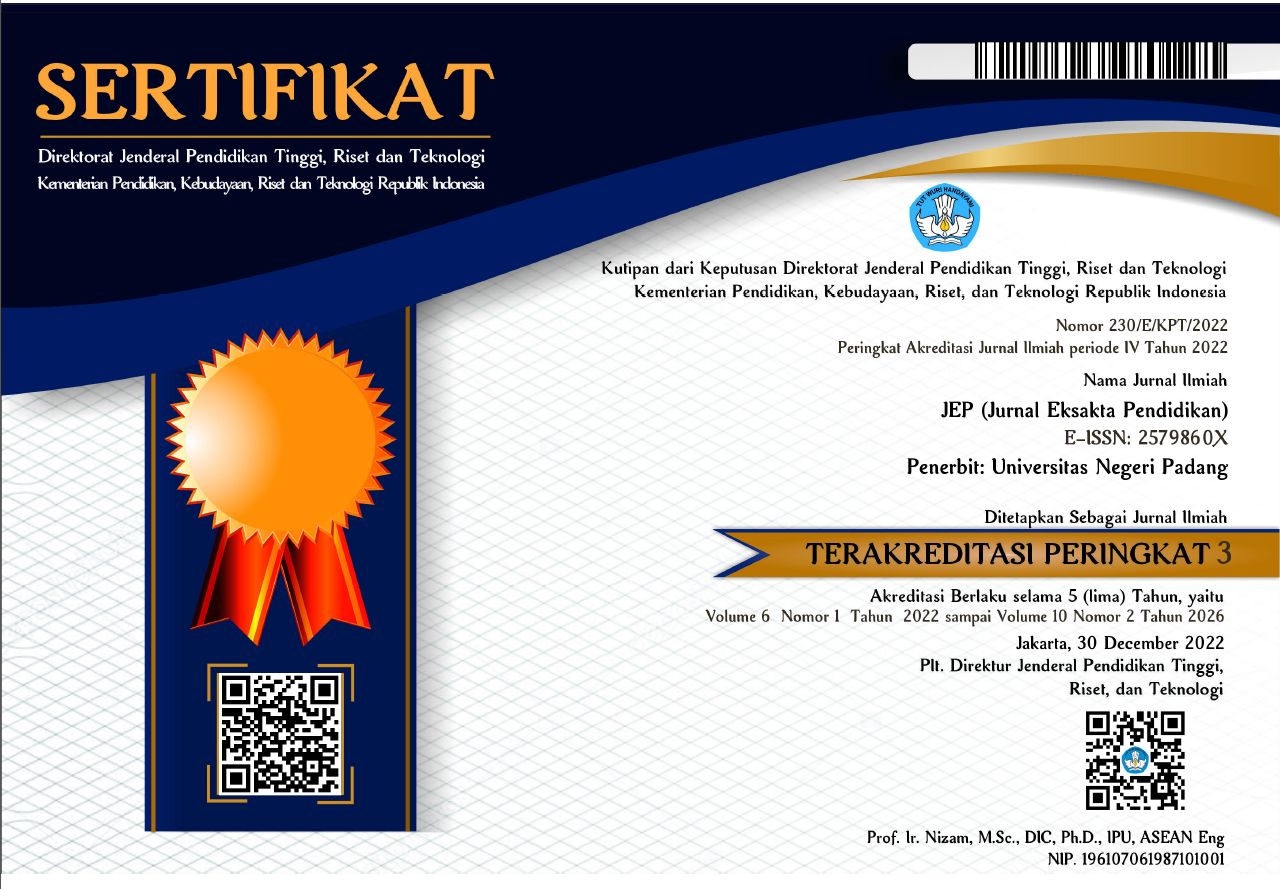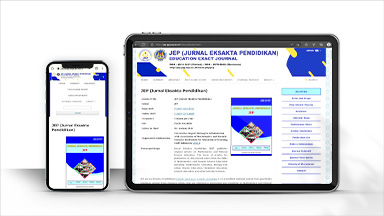Penggunaan Google Jamboard Dalam Pembelajaran Online Terhadap Motivasi Belajar Peserta Didik Pada Materi Arus Bolak Balik
Abstract
This study aims to determine the effect of using Google Jamboard on the motivation of students in the Alternating Flow material. This research is quantitative research with an experimental method. The research design used is the Posttest–Only Controll Group Design. Media with Google Jamboard as the independent variable and student motivation as the dependent variable. The population of this study was all students in class XII IPA SMAS Yuppentek 1 in Tangerang City for the academic year 2020/2021. The sample for this study consisted of 2 classes, namely, class XII IPA 3 as the experimental class and class XII IPA 5 as the control class. The sampling technique was random sampling. Data collection techniques using Posttest and Learning Motivation Questionnaires to measure students' learning motivation and Observation Sheets for the implementation of learning. The results of this study showed the average value of the ability of students' learning outcomes in the experimental class was 80.56, with a very good category. The average value of students' learning motivation in the experimental class is 73.17, with a good category. Based on the results of the t-test on the two-party pretest averages that tcount < ttable with a total of 0.932 < 1.69, there is no difference in the ability of the experimental class and control class students on alternating current material. Based on the results of the T-test on the one-party posttest showing tcount > ttable with a total of 3.53 > 1.69, it was concluded that there was an increase in the ability of students who received learning using Google Jamboard media compared to students without using Google Jamboard media. The results of the T-test show that, on the one hand, the N-Gain score is tcount > ttable or 11.159 > 1.69, with the conclusion that the experimental class students' abilities are higher than the control class students' abilities on alternating current material. Based on the results of the study, it can be concluded that there is a positive effect of using Google Jamboard on students' learning motivation on alternating current material.
Downloads
References
Atsani, K. L. G. M. Z. (2020). Transformasi Media Pembelajaran pada Masa Pandemi Covid-19. Al-Hikmah: Jurnal Studi Islam, 1(1), 82–93.
Ayudha, C. F. H., & Setyarsih, W. (2021). Studi Literatur : Analisis Praktik Pembelajaran Fisika Di Sma Untuk Melatih Keterampilan Pemecahan Masalah. Jurnal Pendidikan Fisika Undiksha, 11(1), 16.
Bahri, A., Hidayat, W., & Muntaha, A. Q. (2018). Penggunaan Media Berbasis AutoPlay Media Studio 8 untuk Meningkatkan Aktivitas dan Hasil Belajar Siswa : Sebuah Inovasi Media Pembelajaran Using AutoPlay Media Studio 8 -based Media to Improve Students ’ Activities and Learning Outcome : An Innovation of . Proceeding Biology Education Conference, 15(1), 394–401.
Bani, A. (2021). Peningkatan Kemampuan Representasi Matematis Siswa SMP 7 Kota Ternate Melalui Model Pembelajaran Problem Based Learning Pada Materi Teorema Pyhtagoras. Edukasi, 19(2), 161–170.
Bilfaqih, Y., & Qomarudin, M. N. (2015). Esensi Pengembangan Pembelajaran Daring. Deepublish, 1(1), 131.
Damayanthi, A. (2020). Efektivitas Pembelajaran Daring di Masa Pandemi Covid 19. JURNAL SOSIAL :Jurnal Penelitian Ilmu-Ilmu Sosial, 19(3), 189–210.
Djamarah, S. B. (2011). Psikologi Belajar. Jakarta: Rineka Cipta.
Emda, A. (2018). Kedudukan Motivasi Belajar Siswa Dalam Pembelajaran. Lantanida Journal, 5(2), 172.
Hamalik, O. (2009). Proses Belajar Mengajar. Jakarta: Bumi Aksara.
Haryadi, R., & Jannah, R. (2020). Pembelajaran Daring Fisika Pada Siswa Sekolah Menengah Atas ( SMA ). Jurnal Pendidikan, 4(2), 264–268.
Hasanah, E. (2019). Pengaruh Media Jamboard Terhadap Motivasi Belajar dan Hasil Belajar Tajwid. Institut Ilmu Al-Quran.
Khoirunnisa. (2020). Pembelajaran Online pada Masa Pandemi COVID19 sebagai Strategi Pembelajaran dan Capaian Hasil Belajar pada Siswa Kelas III B MI AL-Ittihaad Citrosono Kecamatan Grabag Kabupaten Magelang Tahun Pelajaran 2019/2020. 21(1), 1–9.
Kurniasari, Wijaya, A., Fransiska, T., Prasetyo, A., Cahyani, P. I., & Kopong, A. Y. (2020). Pengembangan Media Pembelajaran Fisika Berbasis Board Game untuk Meningkatkan Hasil Belajar Fisika Peserta Didik SMA Kelas X. Wahana Pendidikan Fisika, 5(1), 49–55.
Mahitsa, M., & Mahardini, A. (2020). Analisis Situasi Penggunaan Google Classroom pada Pembelajaran Daring Fisika. Jurnal Pendidikan Fisika, 8(2), 215–224.
Munir. (2009). Pembelajaran Jarak Jauh Berbasis Teknologi Informasi dan Komunikasi. Retrieved from www. cvalbeta.com
Napsawati, N. (2020). Analisis Situasi Pembelajaran Ipa Fisika Dengan Metode Daring Di Tengah Wabah Covid-19. Karst : Jurnal Pendidikan Fisika dan Terapannya, 3(1), 96–102.
Nurfalah, E. (2019). Optimalisasi E-Learning berbasis Virtual Class dengan Google Classroom sebagai Media Pembelajaran Fisika. Physics Education Research Journal, 1(1), 46.
Rima, E. (2016). Ragam Media Pembelajaran. Yogyakarta: Kata Pena.
Setyadi, A. (2017). Penggunaan Model Talking Stick Terhadap Kemampuan Kognitif dan Motivasi Belajar pada Konsep Sistem Pernapasan Manusia di SMPN 1 Kalanganyar. Untirta.
Shabrina, A., & Diani, R. (2019). Pengembangan Media Pembelajaran Fisika Berbasis Web Enhanced Course dengan Model Inkuiri Terbimbing. Indonesian Journal of Science and Mathematics Education, 2(1), 9–26.
Sugiyono. (2014). Metode Penelitian Kuantitatif, Kualitatif dan R&D. Bandung: Alfabeta.
Suryandari, Ayu Wuly, burhendi, feli cianda adrin. (2020). Studi Pendahuluan Karakteristik Pembelajaran Online Fisika Selama Masa Pandemi COVID-19. Jurnal Pendidikan Dasar, 1–9.
Suryosubroto, B. (2009). Proses Belajar Mengajar. Jakarta: Rineka Cipta.
Thobroni, M. (2015). Belajar dan Pembelajaran Teori dan Praktik. Yogyakarta: Ar - Ruzz Media.
Yanto, D. T. P. (2019). Praktikalitas Media Pembelajaran Interaktif pada Proses Pembelajaran Rangkaian Listrik. INVOTEK: Jurnal Inovasi Vokasional dan Teknologi, 19(1), 75–82.
Copyright (c) 2022 Reni Musriyanti

This work is licensed under a Creative Commons Attribution 4.0 International License.

This work is licensed under a Creative Commons Attribution 4.0 International License.




_(2579-860X).png)
_(2614-1221)1.png)




